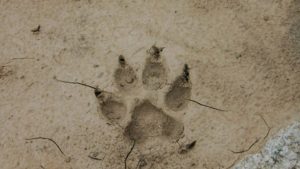
I love the coverage from the Santa Fe Reporter about the Mexican wolf Asha who left her Arizona pack and traveled to New Mexico in search of a mate. One of the article’s featured images is that of a wolf paw print that I found compelling in the article published in conjunction with PBS in NM.
https://www.sfreporter.com/news/coverstories/2023/01/25/northward-peril/ Links to an external site
A key image (see above) is the one of a wolf footprint on a bare background, a compelling image, because it is one of many we have seen featured in the past in books and articles highlighting other predators that are now endangered. This photo is evocative and leads the unsuspecting reader into an unexpected world.
The article relies on detailed information from official government sources responsible for the reintroduction of the Mexican wolf in the Southwest and over the border in Mexico.
The image is simple and stark which evokes both fear and fascination in those who see it. Few Southwestern residents in the present, however, will be so fortunate. After reading the featured piece in the SF Reporter or searching for more data about this topic of an endangered species and an official reintroduction program, the reader realizes that we’re speaking of only a few hundred actual critters.
One day I was sitting outside my writing retreat cabin north of Espanola when two large wolf-like creatures ran toward and around me. I wondered if they were a male and female couple, but I was clueless about the origins of these canines. They were large, frisky, and healthy. No one living locally could offer an explanation. I wondered if they may have been wolf-dogs out for exercise.
That’s when I first heard about consumer experimentation with a wolf-domestic dog mix that a certain number of NM residents and others have chosen in the past for domestic pets. Unfortunately, this combination creates a handful for families and others. Eventually, many end up in state wildlife refuges where they are not eligible for adoption due to their more aggressive personality characteristics.
Perhaps these two peculiar examples running near me were of this origin, as they didn’t appear to be bothered by me, sitting outside. And I was to find out later that wolf reintroduction programs are often controversial and word spreads locally very fast if such a program is operative nearby. I became interested in Southwest wolves and other wildlife endangered and up against the interests of cattle ranchers, some of whom are very protective of their commercial livestock.
The photo featured stands as the representation of the detail offered by the writer of the feature article that includes first person memories, imaginative riffs, the facts about this particular female wolf, named Asha by a state seventh grader, and much more.
There are action campaigns and other offerings associated with this photo image available on the internet, as well as links for updates about this particular wolf and her journey north of I40 to where she was captured and waits another relocation and a mate who hopefully will stabilize her genetic background. The associated photo speaks volumes about how the topic opens beyond expectations for any reader or viewer.
This is an example of what one photo can inspire, plus information available to stand as an overview of animal relocation efforts up against commercial interests today. There’s plenty of human and wildlife feature content in the related coverage. The future of wolf relocation efforts is one one to interest tens of thousands of Southwest and beyond residents. Such an example is associated with topics such as climate change, human policy, and a future we humans are beginning to imagine and come to terms with.
Suffrage Wagon News Channel has been publishing since 2009.
What’s ahead for the “Spirit of 1776” suffrage wagon? on Vimeo.

